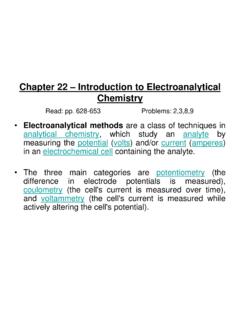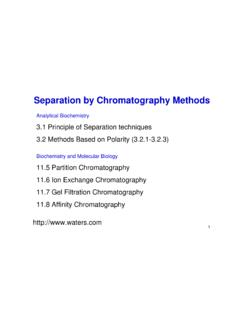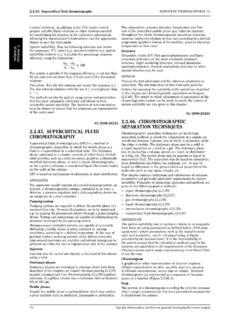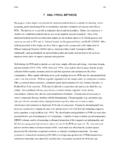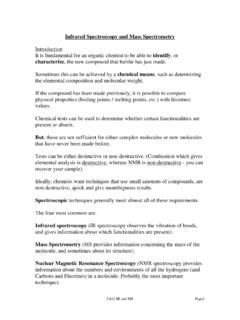Transcription of SEPARATION TECHNIQUES - INTRODUCTION
1 SEPARATION TECHNIQUES -INTRODUCTIONSIVASWAROOP OF SEPARATION TECHNIQUES :TO IDENTIFY WHAT TO BE SEPARATED FROM OBTAIN IMPORTANT AND PURE REMOVE UNWANTED PARTICLES. TYPES OF SEPARATION TECHNIQUES : SEPARATION TECHNIQUES are classified based on type of mixtures: SEPARATION techniquesFor solid in liquid mixturesHomogenous:1. Evaporation 2. Distillation 3. centrifugationHeterogenous:1. Sedimentation / gravitation 2. Filtration 3. Magnetic separation4. Fractional distillationFor liquid in liquid mixturesHomogenous:1. Simple or fractional distillation. 2. Chromatography Heterogenous:1. Partition SEPARATION using funnel MAGNETIC ,soitusefulonlyforcertainsubstancessucha sferromagnetic(materialsstronglyaffected bymagneticfields)andparamagnetic(materia lsthatarelessaffected,buttheeffectisstil lnoticeable).Thismethodinvolvesthesepara tionofmagneticsubstancesfromnon-magnetic substancesbymeansofmagnet. Applications: Wastemanagement,low-magneticfieldseparat ioninwaterpurificationandseparationofcom plexmixtures.
2 Toremovemetalcontaminantsfrompharmaceuti calproductstreams. ,morespecificallyincancerandhereditarydi seasesresearches. ThesetechniquesarecombinedwithPCR(polyme rasechainreaction), liquid SEPARATION : Takes advantage of differences in density of the liquids. Aseparatory funnelis an alternative apparatus for separating liquid has a valve at the bottom to allow draining off the bottom layer. It can give a better SEPARATION between the two liquids. Example: SEPARATION of mixture of oil and water. Takesadvantageofgravity/sedimentationofs olidsincasesolid-liquidseparation. Sedimentation: The tendency ofparticlesinsuspensionto settle down in the fluid due to certain forces like gravity,centrifugal acceleration, orelectromagnetism is called as sedimentation. Thesolidthatgetssettleddowniscalledassed iment. angletoallowthesedimentstosettleatthebot tomoftheapparatus. SEPARATION :Examples/applications: Decantation is frequently used to purify a liquid by separating it from a suspension ofinsoluble particles.
3 Decantation is also present innanotechnology. In the synthesis of high-quality silver nanowire (AgNW) solutions and fabrication process of high-performance electrodes, decantation is also being applied which greatly simplifies the purification process. Fat is determined in butter by decantation. In sugar industry, processing of sugar beets into granular sugar many liquid -solid separations are :Takes advantage of physical property of state of matter, its size and solubility in liquid. The substance which is left behind in the filtration medium is called residue. The liquid which passes through the filtration medium is called filtrate. Mechanical, physical or biological operations that separates solids from fluids (liquidsorgases ) by adding a medium through which only the fluid can pass can be called as :Most important TECHNIQUES used by chemists to purify inair conditioningto remove particles from the laboratory, aB chner funnelis often used, with afilter paperserving as the porous :Itisusedtoseparatemixtureswherethesolid particlesdon tsettlefasterandwhichareofverysmallsizea ndcan' ,shape,density, (movetotheoutside),whileless-densecompon entsofthemixturemigratetowardstheaxis, , (RPM), :Microcentrifuges are used to process small volumes of biological molecules,cells, in diagnostic laboratories for blood and urine in SEPARATION of proteins using purification TECHNIQUES such assalting Centrifugation used to separate organelles and membranes found in.
4 Evaporation is type of vaporization that occurs on the surface of liquid as it changes into gas SEPARATION technique can be used to separate solutes that are dissolved in solvent, by boiling the solution. The solvent gets vaporized leaving back the solute. Factors affecting: Concentrationof the substance evaporating in the air. Flow rate of air, pressure, temperature. Surface area. Intermolecular forces. Evaporation equipment:Natural circulation evaporators:Evaporating still and short circulation evaporators:Climbing film film : Recoveringsaltsfromsolution. Theuseofevaporationtodryorconcentratesam plesisacommonpreparatorystepformanylabor atoryanalysessuchasspectroscopyandchroma tography. :Distillationisaneffectivemethodtosepara temixturescomprisedoftwoormorepureliquid s(called components ). (turnstoavapor).Thevaporisthenfedintoaco ndenser, "residue".Simple distillation:Fractional distillation:Types:Simple: Used to separate liquid mixtures which boil without decomposition and have enough difference in their boiling : SEPARATION of acetone and of : Fractional distillation is used for the SEPARATION of a mixture of two or more miscible liquids for which the difference in boiling points is less than 25K.
5 The apparatus for fractional distillation is like that of simple distillation, except that a fractionating column is fitted in between the distillation flask and the : SEPARATION of different fractions from petroleum of a mixture of methanol and applications/examples: SEPARATION of volatile of drugs obtained from plant or animal sources vitamin A from fish liver of organic of official preparations spirit of nitrous ether, spirit of ammonia, distilled water, and water for petroleum products. CRYSTALLIZATION: Crystallizationisthe(naturalorartificial )processbywhichasolidforms,wheretheatoms ormoleculesarehighlyorganizedintoastruct ureknownasacrystal. Usedtoseparateadissolvedheat-liable(will decomposeuponheatingandhencecansublime)s olid(solute)fromasolution. Mostmineralsandorganicmoleculescrystalli zeeasily,andtheresultingcrystalsaregener allyofgoodquality, , ,thehotsolutiontoiskeptforcooling, , Purificationofdrugs. Separationofcrystalsofalumfromimpurities sample.
6 FractionalCrystallization:Itispossibleto separatemixturesofdifferentioniccompound shavingidenticalchemicalcompositionbydis solvingtheminwaterandadjustingthetempera tureofthesolutionsothatonecompoundcrysta llizesoutandtheotherdoesnot. :SUBLIMATION SEPARATION : Sublimationisthetransitionofasubstancedi rectlyfromthesolidtothegasphase,withoutp assingthroughtheintermediateliquidphase. Thistechniquetakestheadvantageofsubstanc e ssublimableproperty. Separateamixtureofsolidscontainingonewhi chsublimesandone(ormorethanone)whichdoes not, : Separate iodine from sand. Dye-sublimation printers help in rendering digital pictures in a detailed and realistic fashion which helps in the analysis of substances. Sublimation finds practical application in forensic sciences. Chemists usually prefer sublimation as a purification method to purify volatile : Chromatographyisaseparationtechniqueused toseparatethedifferentcomponentsinaliqui dmixture. Themixtureisdissolvedinafluidcalledthemo bilephase,whichcarriesitthroughastructur eholdinganothermaterialcalledthestationa ryphase.
7 TECHNIQUES : Involvestheseparationofmedicinallyactive portionsofplantoranimaltissuesfromtheina ctiveorinertcomponentsbyusingselectiveso lventsinstandardextractionprocedures. Differentmethodsofextractionare:MethodSo lventTemperaturePressureTimeVolume of organic solvent consumedPolarity of natural products extractedMacerationWater, aqueous and non-aqueous solventsRoom temperatureAtmosphericLongLargeDependent on extracting solventPercolationWater, aqueous and non-aqueous solventsRoom temperature, occasionally under heatAtmosphericLongLargeDependent on extracting solventDecoctionWaterUnder heatAtmosphericModerateNonePolar compoundsReflux extractionAqueous and non-aqueous solventsUnder heatAtmosphericModerateModerateDependent on extracting solventSoxhlet extractionOrganic solventsUnder heatAtmosphericLongModerateDependent on extracting solventPressurized liquid extractionWater, aqueous and non-aqueous solventsUnder heatHighShortSmallDependent on extracting solventSupercritical fluid extractionSupercritical fluid (usually S-CO2)
8 , sometimes with modifierNear room temperatureHighShortNone or smallNonpolar to moderate polar compoundsUltrasound assisted extractionWater, aqueous and non-aqueous solventsRoom temperature, or under heatAtmosphericShortModerateDependent on extracting solventMicrowave assisted extractionWater, aqueous and non-aqueous solventsRoom temperatureAtmosphericShortNone or moderateDependent on extracting solventPulsed electric field extractionWater, aqueous and non-aqueous solventsRoom temperature, or under heatAtmosphericShortModerateDependent on extracting solventEnzyme assisted extractionWater, aqueous and non-aqueous solventsRoom temperature, or heated after enzyme treatmentAtmosphericModerateModerateDepe ndent on extracting solventHydro distillation and steam distillationWaterUnder heatAtmosphericLongNoneEssential oil (usually non-polar)THANK YOU



